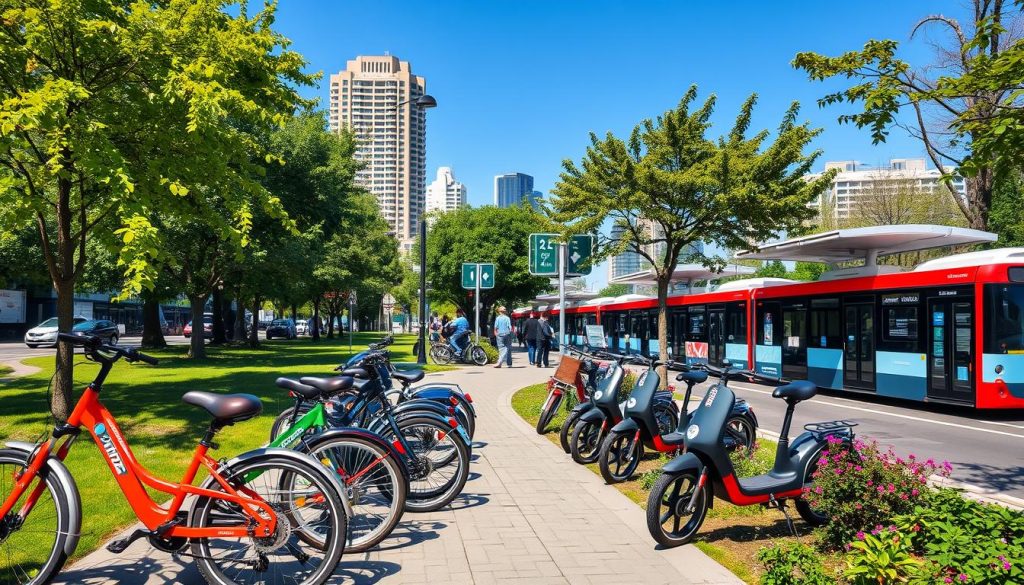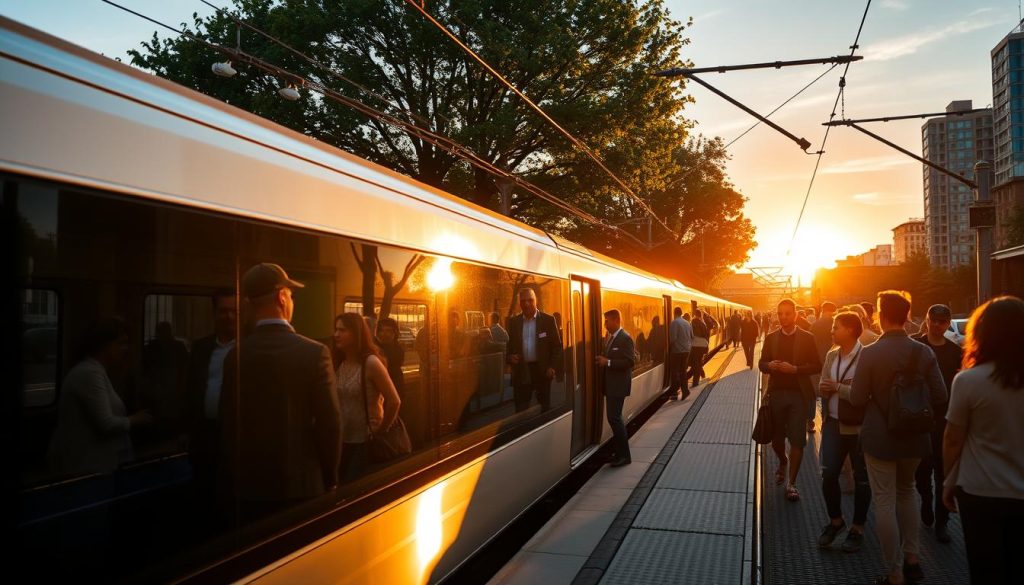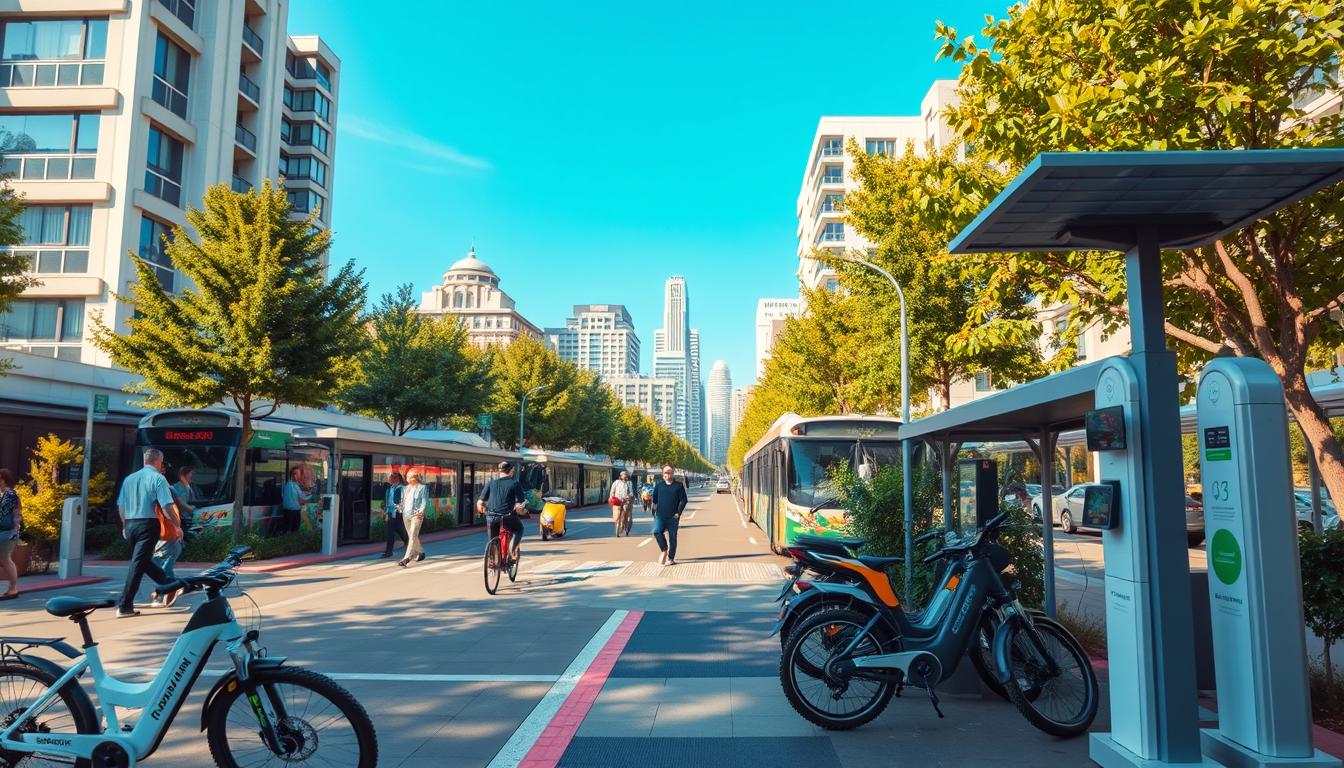I never thought my daily commute could make a difference. But learning about sustainable transportation changed my view. Eco-friendly commuting became my goal, and I started a green mobility journey.
This journey showed me cleaner air and healthier living. I found cycling paths, efficient public transit, and the joy of walking. These small steps had big effects on my life and the environment.
Join me as I share my experiences, challenges, and triumphs in adopting low-impact commuting. You’ll get practical tips, find inspiration, and maybe start your own green commute revolution.
What Is Low-Impact Commuting?
Low-impact commuting is a way to travel that’s kind to the planet. It means picking transport that cuts down on pollution and boosts our health.
Definition and Key Concepts
At its heart, low-impact commuting means avoiding cars. It’s about walking, biking, and using public transport. These choices help make cities better for walking and cut down on car use.
Environmental Benefits of Sustainable Transportation
Choosing green transport can greatly lower emissions. By picking active travel, we clean the air and quiet down our streets. It also helps build greener cities.
Health Advantages of Active Travel
Active travel is great for our health. Walking or biking to work keeps us fit and lowers stress. It’s a simple way to exercise every day. I’ve also noticed better focus and energy since starting.
| Commute Type | Environmental Impact | Health Benefits |
|---|---|---|
| Walking | Zero emissions | Cardiovascular health, weight management |
| Cycling | Zero emissions | Muscle strength, improved stamina |
| Public Transit | Reduced per-person emissions | Increased physical activity, reduced stress |
By picking low-impact travel, I’m doing good for the planet and myself. I’m helping make cities better for everyone.
My Personal Wake-Up Call: Why I Decided to Go Green
One morning, I was stuck in traffic and saw exhaust fumes everywhere. It made me realize I was contributing to pollution. This moment made me want to switch to green mobility.
The numbers shocked me. My daily drive was causing over 4,000 pounds of CO2 emissions each year. I knew I had to find ways to cut down on my carbon footprint.
My commute was also harming my health. I was stressed and not active enough. Walking or cycling seemed like a great way to stay healthy and help the planet.
| Factors | Before | After Green Mobility |
|---|---|---|
| CO2 Emissions | 4,000 lbs/year | 500 lbs/year |
| Stress Levels | High | Low |
| Physical Activity | Sedentary | Active |
| Commute Cost | $200/month | $50/month |
Looking into eco-friendly commuting, I found many options. My city had public transit and bike-sharing programs. Saving money and helping the environment made me choose a greener commute.
Assessing My Carbon Footprint: The Shocking Reality
I decided to start low-impact commuting and face my carbon footprint. I began by looking at my daily commute emissions. What I found was shocking.
Calculating My Daily Commute Emissions
I used an online carbon calculator to figure out my emissions. My 20-mile round trip in a big SUV was huge. It was pumping out 4,600 pounds of CO2 every year. That’s like the weight of two adult elephants!
Understanding the Long-Term Impact
The long-term effects of my driving were really scary. Over ten years, my solo driving would add 46,000 pounds of CO2 to the air. This made me want to find better ways to travel.
Setting Goals for Reduction
With this new knowledge, I set big but doable goals to lower my carbon footprint:
- Cut my car usage by 50% in three months
- Choose cycling or walking for trips under 5 miles
- Use public transit at least twice a week
| Commute Method | Annual CO2 Emissions (lbs) | 10-Year CO2 Emissions (lbs) |
|---|---|---|
| Car (SUV) | 4,600 | 46,000 |
| Public Transit | 2,300 | 23,000 |
| Cycling/Walking | 0 | 0 |
This comparison made me even more determined to change. I was ready to make a big difference in my daily travel and reduce my carbon footprint a lot.
Exploring Eco-Friendly Commuting Options in My City

Living in a bustling urban area, I’m lucky to have many green transportation choices. My city has worked hard to improve cycling, public transit, and commuter rail. These options help reduce my carbon footprint and make my daily commute better.
Cycling is getting more popular with the help of bike lanes and shared paths. It keeps me fit and saves money on gas. The city’s bike-sharing program makes it easy to use a bike, even if I don’t own one.
Public transit includes a wide bus network and light rail system. Buses run often and cover many areas. The light rail is quick for crossing town. I enjoy relaxing, reading, or checking emails during my commute, avoiding traffic.
For longer trips, our commuter rail connects suburbs to the city center. It’s comfy with Wi-Fi and schedules for work hours. Train stations have park-and-ride spots, making it easy to use both driving and public transit.
| Commute Option | Pros | Cons |
|---|---|---|
| Cycling | Exercise, no fuel costs | Weather-dependent, limited cargo space |
| Public Transit | Relaxing, environmentally friendly | Fixed schedules, potential delays |
| Commuter Rail | Fast for long distances, productive time | Higher cost, limited flexibility |
Exploring these options, I’ve found mixing and matching works best for me. Some days I cycle, others I take a bus and walk. The key is being flexible and choosing what fits my schedule and needs while being eco-friendly.
Cycling: My New Two-Wheeled Adventure
Starting to use a bike as my main way to get around was thrilling. It was a big change from driving a car. Not only did it cut down on pollution, but it also made me feel better.
Choosing the Right Bike for Commuting
Finding the right bike was key. I picked a hybrid bike, which was fast yet comfy. It was perfect for city streets and made my rides smooth.
Essential Gear for Safe Cycling
My safety was my main concern. I got a bright helmet, lights, and reflective clothes. These helped me stay seen by others while I cycled.
Navigating City Streets and Bike Lanes
Figuring out the city’s bike paths was tough but rewarding. I learned the best routes and stayed alert for dangers. Now, my rides are safer and more fun.
| Cycling Infrastructure | Benefits | Challenges |
|---|---|---|
| Dedicated Bike Lanes | Increased safety, faster commutes | Limited availability in some areas |
| Shared Paths | Scenic routes, separated from traffic | Navigating pedestrian traffic |
| Bike Parking Facilities | Secure storage, encourages cycling | Sometimes limited spaces available |
My cycling journey has turned my daily trip into something exciting. The better bike paths and facilities make cycling easier and more fun for city riders like me.
Public Transit: Rediscovering the Joys of Riding the Bus and Train

I’ve fallen in love with public transit all over again. Riding the bus and train has become my favorite part of the day. It’s not just about getting from point A to B anymore. It’s a chance to relax, catch up on reading, or chat with fellow commuters.
The biggest perk? I’m doing my part for the environment. By choosing public transit over driving, I’ve cut my carbon footprint significantly. Plus, I save a ton on gas and parking fees.
Commuter rail has been a game-changer for my longer trips. The smooth ride lets me work on my laptop or enjoy the scenery. I’ve even made some new friends during my regular journeys.
To make the most of my public transit time, I’ve developed a few strategies:
- Download podcasts or e-books for entertainment
- Use noise-canceling headphones for a peaceful ride
- Bring a reusable water bottle and snacks
- Use transit apps to track arrival times and plan routes
Of course, there are challenges. Crowded buses during rush hour can be frustrating. But I’ve learned to be patient and remember the bigger picture. We’re all in this together, working towards a more sustainable future.
| Mode | CO2 Emissions (per passenger mile) | Average Speed in City |
|---|---|---|
| Car | 0.96 lbs | 27.6 mph |
| Bus | 0.64 lbs | 12.7 mph |
| Commuter Rail | 0.33 lbs | 33.0 mph |
Embracing public transit has been a rewarding experience. It’s not just about reducing my environmental impact. It’s about rediscovering the joy of the journey itself.
Walking: The Ultimate Low-Impact Commute
Walking to work is my top choice for active travel. It’s easy and helps cut down on carbon emissions while keeping me healthy. In cities where walking is easy, more people are choosing this green way to get to work.
Health Benefits of Walking to Work
Walking to the office has changed my life for the better. It’s made my heart healthier, improved my mood, and given me more energy. It also helps me stay at a healthy weight and lowers my stress levels before work.
| Benefit | Impact on My Health |
|---|---|
| Cardiovascular Health | Lowered blood pressure and improved heart function |
| Mental Well-being | Reduced stress and anxiety, better overall mood | Weight Management | Consistent calorie burn, helping maintain healthy weight |
| Energy Levels | Increased stamina and alertness throughout the day |
Planning Efficient Walking Routes
To get the most out of my walk, I plan my route well. I use apps to find the fastest ways and find pretty paths through parks or quiet areas. This way, I get to work on time and enjoy the walk.
Staying Motivated in All Weather
Walking every day, no matter the weather, takes some effort. I dress for the weather with waterproof jackets and comfy shoes. On tough days, I think about the benefits and listen to my favorite podcasts or audiobooks. This keeps me going, rain or shine.
Carpooling and Ride-Sharing: Connecting with Fellow Green Commuters

I’ve found that carpooling and ride-sharing are great for cutting down on carbon emissions. They help me get to work quickly and efficiently. These options are now a big part of how I commute.
Finding people to carpool with was simpler than I thought. I asked my coworkers and found out many lived nearby. We started a WhatsApp group to plan our rides. This not only cuts down on emissions but also strengthens our work friendships.
When carpooling isn’t possible, I use ride-sharing apps. These apps connect me with drivers going my way, saving us both money. It’s incredible how these small steps can make a big environmental difference.
Shared rides do more than just lower emissions. They also save me money on gas and car upkeep. Plus, the chats during my ride make me happier and less stressed. It’s good for my wallet, my mood, and the planet.
- Reduced carbon emissions
- Lower transportation costs
- Decreased traffic congestion
- Improved social connections
By choosing carpooling and ride-sharing, I’ve deepened my commitment to green travel. These choices show that small daily changes can have big, positive effects on our world and communities.
Overcoming Challenges: How I Stayed Committed to Low-Impact Commuting
Switching to green mobility wasn’t easy. I faced many hurdles on my car-free commuting journey. Bad weather, tight schedules, and sometimes just feeling lazy tested my commitment. But I never gave up on my eco-friendly path.
To keep going, I found ways to stay motivated. I started with small, reachable goals. Instead of aiming for every day, I began with just two or three days a week. This made the change easier and more doable.
I also got the right gear for different weather. Good rain clothes and warm layers made cycling and walking comfy all year. For longer trips, I used public transit and cycled, using bike racks on buses to go further.
Planning was my key strategy. I’d pick out my outfit and pack my bag the night before. This stopped me from making excuses in the morning. I also found new routes that were fun, like parks and quiet streets.
Meeting others who shared my goals was a big help. I joined a local green commuters group. We shared tips and support. This community kept me going on hard days.
By tackling these challenges, I not only kept up with low-impact commuting but found joy in it too. The feeling of success and the good it did for my health and the planet was worth any hassle or discomfort.
The Ripple Effect: Inspiring Others in My Workplace
My journey into sustainable transportation sparked curiosity among my coworkers. I saw a chance to spread the green commuting movement. So, I organized a fun green commuting challenge at our office.
Organizing a green commuting challenge
The challenge was simple: use low-impact methods to get to work for a month. We tracked miles traveled and carbon emissions saved. Prizes awaited the top performers.
The excitement was contagious! Soon, our parking lot had more bikes than cars.
Advocating for better cycling infrastructure
As more colleagues took up cycling, we noticed a lack of bike lanes in our area. I started a petition for better cycling infrastructure. We gathered signatures and presented our case to the city council.
Our efforts paid off when new bike lanes were approved near our workplace.
Sharing success stories and tips
I created a bulletin board in our break room to showcase green commuting wins. Coworkers shared their experiences, from weight loss to money saved on gas. I posted weekly tips on sustainable transportation options.
This hub of information became a go-to spot for anyone looking to start their own eco-friendly commute.

